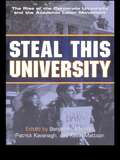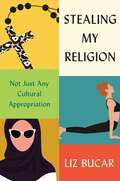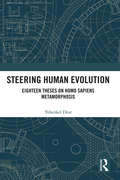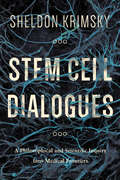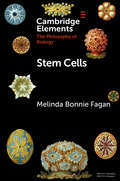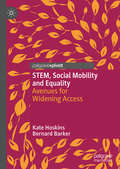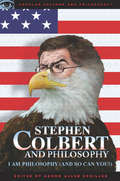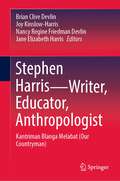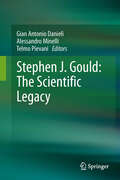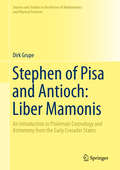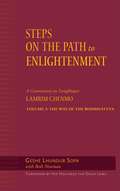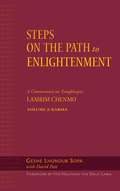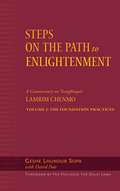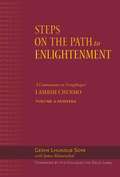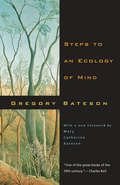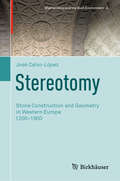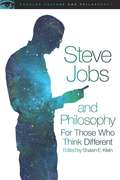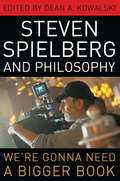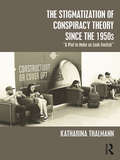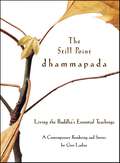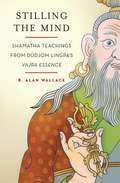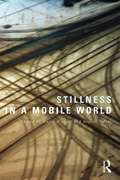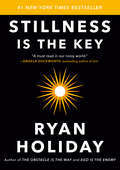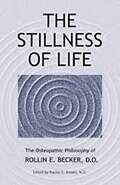- Table View
- List View
Steal This University: The Rise of the Corporate University and the Academic Labor Movement
by Benjamin Johnson Patrick Kavanagh Kevin MattsonSteal This University explores the paradox of academic labor. Universities do not exist to generate a profit from capital investment, yet contemporary universities are increasingly using corporations as their model for internal organization. While the media, politicians, business leaders and the general public all seem to share a remarkable consensus that higher education is indispensable to the future of nations and individuals alike, within academia bitter conflicts brew over the shape of tomorrow's universities. Contributors to the volume range from the star academic to the disgruntled adjunct and each bring a unique perspective to the discussion on the academy's over-reliance on adjuncts and teaching assistants, the debate over tenure and to the valiant efforts to organize unions and win rights.
Stealing My Religion: Not Just Any Cultural Appropriation
by Liz BucarFrom sneaker ads and the “solidarity hijab” to yoga classes and secular hikes along the Camino de Santiago pilgrimage route, the essential guide to the murky ethics of religious appropriation.We think we know cultural appropriation when we see it. Blackface or Native American headdresses as Halloween costumes—these clearly give offense. But what about Cardi B posing as the Hindu goddess Durga in a Reebok ad, AA’s twelve-step invocation of God, or the earnest namaste you utter at the end of yoga class?Liz Bucar unpacks the ethical dilemmas of a messy form of cultural appropriation: the borrowing of religious doctrines, rituals, and dress for political, economic, and therapeutic reasons. Does borrowing from another’s religion harm believers? Who can consent to such borrowings? Bucar sees religion as an especially vexing arena for appropriation debates because faiths overlap and imitate each other and because diversity within religious groups scrambles our sense of who is an insider and who is not. Indeed, if we are to understand why some appropriations are insulting and others benign, we have to ask difficult philosophical questions about what religions really are.Stealing My Religion guides us through three revealing case studies—the hijab as a feminist signal of Muslim allyship, a study abroad “pilgrimage” on the Camino de Santiago, and the commodification of yoga in the West. We see why the Vatican can’t grant Rihanna permission to dress up as the pope, yet it’s still okay to roll out our yoga mats. Reflecting on her own missteps, Bucar comes to a surprising conclusion: the way to avoid religious appropriation isn’t to borrow less but to borrow more—to become deeply invested in learning the roots and diverse meanings of our enthusiasms.
Steck-Vaughn Mathematical Reasoning: Test Preparation For The 2014 GED Test: Student Book
by Paxen Learning Corporation Staff"Algebraic problem solving, quantitative problem solving, mathematical practices"--Cover.
Steering Human Evolution: Eighteen Theses on Homo Sapiens Metamorphosis
by Yehezkel DrorHumanity must steer its evolution. As human knowledge moves a step ahead of Darwin’s theories, this book presents the emergence of human-made meta-evolution shaping our alternative futures. This novel process poses fateful challenges to humanity, which require regulation of emerging science and technology which may endanger the future of our species. However, to do so successfully, a novel ‘humanity-craft’ has to be developed; main ideologies and institutions need redesign; national sovereignty has to be limited; a decisive global regime becomes essential; some revaluation of widely accepted norms becomes essential; and a novel type of political leader, based on merit in addition to public support, is urgently needed. Taking into account the strength of nationalism and vested interests, it may well be that only catastrophes will teach humanity to metamorphose into a novel epoch without too high transition costs. But initial steps, such as United Nation reforms, are urgent in order to contain calamities and may soon become feasible. Being both interdisciplinary and based on personal experience of the author, this book adds up to a novel paradigm on steering human evolution. It will be of great interest to scholars and researchers of modern history, evolution sciences, future studies, political science, philosophy of action, and science and technology. It will also be of wide appeal to the general reader anxious about the future of life on Earth. Comments on the Corona pandemic add to the book’s concrete significance.
Stem Cell Dialogues: A Philosophical and Scientific Inquiry Into Medical Frontiers
by Sheldon KrimskyStem cells and the emerging field of regenerative medicine are at the frontiers of modern medicine. These areas of scientific inquiry suggest that in the future, damaged tissue and organs might be repaired through personalized cell therapy as easily as the body repairs itself, revolutionizing the treatment of numerous diseases. Yet the use of stem cells is fraught with ethical and public policy dilemmas that challenge scientists, clinicians, the public health community, and people of good will everywhere. How shall we deal with these amazing biomedical advances, and how can we talk about potential breakthroughs with both moral and scientific intelligence? This book provides an innovative look at these vexing issues through a series of innovative Socratic dialogues that elucidate key scientific and ethical points in an approachable manner. Addressing the cultural and value issues underlying stem cell research while also educating readers about stem cells' biological function and medical applications, Stem Cell Dialogues features fictional characters engaging in compelling inquiry and debate. Participants investigate the scientific, political, and socioethical dimensions of stem cell science using actual language, analysis, and arguments taken from scientific, philosophical, and popular literature. Each dialogue centers on a specific, recognizable topic, such as the policies implemented by the George W. Bush administration restricting the use of embryonic stem cells; the potential role of stem cells in personalized medicine; the ethics of cloning; and the sale of eggs and embryos. Additionally, speakers debate the use of stem cells to treat paralysis, diabetes, stroke effects, macular degeneration, and cancer. Educational, entertaining, and rigorously researched (with 300 references to scientific literature), Stem Cell Dialogues should be included in any effort to help the public understand the science, ethics, and policy concerns of this promising field.
Stem Cells (Elements in the Philosophy of Biology)
by Melinda Bonnie FaganWhat is a stem cell? The answer is seemingly obvious: a cell that is also a stem, or point of origin, for something else. Upon closer examination, however, this combination of ideas leads directly to fundamental questions about biological development. A cell is a basic category of living thing; a fundamental 'unit of life.' A stem is a site of growth; an active source that supports or gives rise to something else. Both concepts are deeply rooted in biological thought, with rich and complex histories. The idea of a stem cell unites them, but the union is neither simple nor straightforward. This book traces the origins of the stem cell concept, its use in stem cell research today, and implications of the idea for stem cell experiments, their concrete results, and hoped-for clinical advances.
STEM, Social Mobility and Equality: Avenues for Widening Access
by Kate Hoskins Bernard BarkerThis book examines the role of the family in intra and inter-generational social movement. The authors take a genealogical approach to researching social mobility, using a university chemistry department as a case study to explore participants’ motives for pursuing a STEM undergraduate degree and the influences that have shaped them. Assessing the roles of genealogy, family and higher education in shaping their aspirations and careers, the authors examine the contributions of these variables to the students aspirations. With a wealth of empirically rich qualitative data, the authors identify areas where work is required to achieve greater equality of access to high performing chemistry departments and enhance career outcomes, which could be applied more widely. This book will appeal to scholars of educational inequalities and widening access, particularly in terms of STEM education.
Stephen Colbert and Philosophy
by Aaron Allen SchillerAt the head of The Colbert Report, one of the most popular shows on television, Stephen Colbert is a pop culture phenomenon. More than one million people backed his fake candidacy in the 2008 U.S. presidential election on Facebook, a testament to the particularly rich set of issues and emotions Colbert brings to mind. Stephen Colbert and Philosophy is crammed with thoughtful and amusing chapters, each written by a philosopher and all focused on Colbert's inimitable reality - from his word creations (truthiness, wikiality, freem, and others) to his position as a faux-pundit who openly mocks Fox News and CNN. Although most of the discussion is centered around The Colbert Report, this collection does not neglect either his best-selling book, I Am America (And So Can You!), or his public performances, including his incendiary 2006 White House Press Correspondents' Dinner speech.
Stephen Harris—Writer, Educator, Anthropologist: Kantriman Blanga Melabat (Our Countryman)
by Brian Clive Devlin Joy Kinslow-Harris Nancy Regine Friedman Devlin Jane Elizabeth HarrisThis book documents the impact of Stephen Harris’s works in Aboriginal education, Aboriginal learning styles, domains of language use and bilingual-bicultural education. It provides a summary and critique of Stephen Harris's key ideas, particularly those on bilingual-bicultural education. This book also profiles the man, his background, his beliefs and talents. It showcases contributions and personal reflections from Stephen’s family, wife, close colleagues, and many of those influenced by his work. This festschrift explores the professional life and work of Stephen Harris as an educator and anthropologist who worked in the Northern Territory of Australia.
Stephen J. Gould: The Scientific Legacy
by Alessandro Minelli Telmo Pievani Gian Antonio DanieliStephen J. Gould's greatest contribution to science is a revised version of the theory of evolution which offers today a useful framework for understanding progress in many evolutionary fields. His intuitions about the conjunction of evolution and development, the role of ecological factors in speciation, the multi-level interpretation of the units of selection, and the interplay between functional pressures and constraints all represent fruitful lines of experimental research. His opposition to the progressive representations of evolution, the gene-centered view of natural history, or the adaptationist "just-so stories" has also left its mark on current biology. In May 2012, at the Istituto Veneto di Scienze, Lettere ed Arti in Venice, an international panel of scientists and philosophers discussed Stephen J. Gould's legacy, ten years after his death. This book presents a selection of those contributions, chosen for their interest and importance. A broad range of themes are covered: Gould's contribution to evolutionary theory, including the concept of punctuated equilibria and the importance of his pluralism; the Gouldian view of genome and development; Gould's legacy in anthropology; and, finally, the significance of his thought for the human sciences. This book provides a fascinating appraisal of the cultural legacy of one of the world's greatest popular writers in the life sciences. This is the first time that scientists including some of Gould's personal friends and co-authors of papers of momentous importance such as Niles Eldredge have come together to strike a balanced view of Gould's intellectual heritage.
Stephen of Pisa and Antioch: An Introduction to Ptolemaic Cosmology and Astronomy from the Early Crusader States (Sources and Studies in the History of Mathematics and Physical Sciences)
by Dirk GrupeThis volume aims to make Stephen of Pisa and Antioch’s work on the celestial sciences accessible to a wider readership, providing not just the text but a translation and introduction as well. The edition is based on the only known manuscript of the Liber Mamonis, MS Cambrai, Médiathèque d’Agglomération, A 930. It is split into two parts: the first provides an extensive introduction to Stephen and his work, while the second features the edition and translation. A comprehensive glossary and collection of photographs of plates are also included.
Steps on the Path to Enlightenment
by His Holiness the Dalai Lama Beth Newman Geshe Lhundub Sopa David PattSteps on the Path to Englightenment: The Foundation Practices marks the first volume of a much-anticipated, comprehensive commentary on the Lamrim Chenmo by the renowned Buddhist scholar, Geshe Sopa. This landmark commentary on what is perhaps the most elegant Tibetan presentation of the Buddhist path offers a detailed overview of Buddhist philosophy, especially invaluable to those wanting to enact the wisdom of the Buddha in their lives. In the Lamrim Chenmo, Tsongkhapa explains the path in terms of the three levels of practitioners: those of small capacity who seek happiness in future lives, those of medium capacity who seek liberation from the cycle of suffering, and those of great capacity who seek full enlightenment in order to benefit all beings. This volume covers the topics common to the first level: Tsongkhapa's explanations of the role of the teacher, his exhortation to take the essence of human existence, the contemplation of death and future lives, and going for the refuge. Given his vast knowledge and his experience in both Tibetan and Western contexts, Geshe Sopa is the ideal commentator of this work for the modern student of Tibetan Buddhism.
Steps on the Path to Enlightenment
by His Holiness the Dalai Lama David Patt Geshe Lhundub SopaThis second volume of the five-volume commentary by the renowned Buddhist scholar Geshe Lhundub Sopa focuses on the key Buddhist concepts of karma, or cause and effect, and dependent origination. Considered one of the finest living Buddhist scholars, Geshe Sopa provides commentaries essential for anyone interested in a sound understanding of Tibetan Buddhist practice and philosophy. Never has a book gone into such clear detail on karma and dependent origination--concepts which, despite many references in contemporary culture, are too often misunderstood. Here, Geshe Sopa starts from the beginning with a faithful reading of the Lamrim Chenmo and, in the end, leaves readers with the proper tools for incorporating core Buddhist concepts into their study, teaching, and practice.
Steps on the Path to Enlightenment: The Foundation Practices
by Beth Newman David Patt Geshe Lhundub Sopa His Holiness the Dalai LamaSteps on the Path to Englightenment: The Foundation Practices marks the first volume of a much-anticipated, comprehensive commentary on the Lamrim Chenmo by the renowned Buddhist scholar, Geshe Sopa. This landmark commentary on what is perhaps the most elegant Tibetan presentation of the Buddhist path offers a detailed overview of Buddhist philosophy, especially invaluable to those wanting to enact the wisdom of the Buddha in their lives. In the Lamrim Chenmo, Tsongkhapa explains the path in terms of the three levels of practitioners: those of small capacity who seek happiness in future lives, those of medium capacity who seek liberation from the cycle of suffering, and those of great capacity who seek full enlightenment in order to benefit all beings. This volume covers the topics common to the first level: Tsongkhapa's explanations of the role of the teacher, his exhortation to take the essence of human existence, the contemplation of death and future lives, and going for the refuge. Given his vast knowledge and his experience in both Tibetan and Western contexts, Geshe Sopa is the ideal commentator of this work for the modern student of Tibetan Buddhism.
Steps on the Path to Enlightenment
by Geshe Lhundub Sopa James BlumenthalAn exploration of the practice of samatha, the style of meditation devoted to focus and attentionGeshe Sopa continues his elucidation of Lama Tsongkhapa's masterwork on the Buddhist path with an explanation of the core meditative practice of samatha, or calm abiding. Showing how it is absolutely essential for--and goes hand in hand with--the achievement of insight into reality, he gives practical tips for countering sleepiness, agitation, and their more subtle counterparts. Leading us step by step toward deeper levels of concentration, volume 4 of the Steps on the Path to Enlightenment series brings readers closer to the ultimate goal of samatha: unlimited and effortless focus.
Steps to an Ecology of Mind
by Gregory BatesonGregory Bateson was a philosopher, anthropologist, photographer, naturalist, and poet, as well as the husband and collaborator of Margaret Mead. With a new foreword by his daughter Mary Katherine Bateson, this classic anthology of his major work will continue to delight and inform generations of readers. "This collection amounts to a retrospective exhibition of a working life. . . . Bateson has come to this position during a career that carried him not only into anthropology, for which he was first trained, but into psychiatry, genetics, and communication theory. . . . He . . . examines the nature of the mind, seeing it not as a nebulous something, somehow lodged somewhere in the body of each man, but as a network of interactions relating the individual with his society and his species and with the universe at large. "—D. W. Harding, New York Review of Books "[Bateson's] view of the world, of science, of culture, and of man is vast and challenging. His efforts at synthesis are tantalizingly and cryptically suggestive. . . . This is a book we should all read and ponder. "—Roger Keesing, American Anthropologist Gregory Bateson (1904-1980) was the author of Naven and Mind and Nature.
Stereotomy: Stone Construction and Geometry in Western Europe 1200–1900 (Mathematics and the Built Environment #4)
by José Calvo-LópezThis book deals with the general concepts in stereotomy and its connection with descriptive geometry, the social background of its practitioners and theoreticians, the general methods and tools of this technology, and the specific procedures for the members built in hewn stone, including arches, squinches, stairs and vaults, ending with a chapter discussing the open problems in this field. Thus, it can be used as a reference book in the subject, but it can also read as a compelling narrative on this subject, one of the main branches of pre-industrial technology. Construction in hewn stone requires the use of geometrical methods and tools to assure that individual stones, either blocks or voussoirs, fit with one another and conform to the general shape of walls, arches or vaults. During the Late Middle Ages and the Renaissance, such techniques and instruments were developed empirically by masons and architects. Later on, learned mathematicians and engineers introduced refinements in these procedures and this branch of knowledge, known as stereotomy, furnished much material to descriptive geometry, a science born with the French Revolution which provided the foundation for projective geometry.
Steve Jobs and Philosophy
by Shawn E. KleinIn Steve Jobs and Philosophy sixteen philosophers take a close look at the inspiring yet often baffling world of Steve Jobs. What can we learn about business ethics from the example of Jobs? What are the major virtues of a creative innovator?<P><P> How could Jobs successfully defy and challenge conventional business practices? How did Jobs combine values and attitudes previously believed to be unmixable? What does it really mean to "think different"? Can entrepreneurs be made or are they just born? If Jobs didn't make any major inventions, just what was his contribution? How is Jobs's life illuminated by Buddhism? How does a counter-culture transform mainstream culture? What does Jobs teach us about the notions of simplicity and functionality in design? How do Jobs's achievements alter the way we think about technology in relation to human life? The chapters cover vital issues in ethics, business, aesthetics, and technology. They are followed by a fascinating appendix listing all the philosophers mentioned in the book, along with explanations of their lives and key themes in their thoughts. Steve Jobs and Philosophy is aimed at readers interested Jobs himself, in entrepreneurship, in technology, culture, and values.
Steven Spielberg and Philosophy: We're Gonna Need a Bigger Book (The Philosophy of Popular Culture #Ppcs)
by Dean A. KowalskiWithout question, few directors have had such a powerful influence on the film industry and the moviegoing public as Steven Spielberg. Often referred to as the most successful American filmmaker of all time, Spielberg has been nominated for the Academy Award for Best Director six times, winning twice -- for Schindler's List in 1994 and Saving Private Ryan in 1999. Seven of his films have received the Best Picture Oscar nomination. He has brought to life some of the most popular heroes of all time, such as Indiana Jones, as well as some of the most despised villains, including Amon Goeth from Schindler's List and the killer shark from Jaws. Whatever the subject -- dinosaurs, war, extra-terrestrials, slavery, the Holocaust, or terrorism -- one clear and consistent touchstone is present in all of Spielberg's films: an interest in the human condition. In Steven Spielberg and Philosophy, Dean A. Kowalski and some of the nation's most respected philosophers investigate Spielberg's art to illuminate the nature of humanity. The book explores rich themes such as cinematic realism, fictional belief, terrorism, family ethics, consciousness, virtue and moral character, human rights, and religion in Spielberg's work. Avid moviegoers and deep thinkers will discover plenty of common ground in this collection.
The Stigmatization of Conspiracy Theory since the 1950s: "A Plot to Make us Look Foolish" (Conspiracy Theories)
by Katharina ThalmannAre conspiracy theories everywhere and is everyone a conspiracy theorist? This ground-breaking study challenges some of the widely shared assessments in the scholarship about a perceived mainstreaming of conspiracy theory. It claims that conspiracy theory underwent a significant shift in status in the mid-20th century and has since then become highly visible as an object of concern in public debates. Providing an in-depth analysis of academic and media discourses, Katharina Thalmann is the first scholar to systematically trace the history and process of the delegitimization of conspiracy theory. By reading a wide range of conspiracist accounts about three central events in American history from the 1950s to 1970s – the Great Red Scare, the Kennedy assassination, and the Watergate scandal – Thalmann shows that a veritable conspiracist subculture emerged in the 1970s as conspiracy theories were pushed out of the legitimate marketplace of ideas and conspiracy theory became a commodity not unlike pornography: alluring in its illegitimacy, commonsensical, and highly profitable. This will be of interest to scholars and researchers interested in American history, culture and subcultures, as well, of course, to those fascinated by conspiracies.
The Still Point Dhammapada: Living the Buddha's Essential Teachings
by Geri LarkinThe Dhammapada is much loved by Buddhist practitioners as a simple and straightforward rendition of some of Buddha's core teachings, and is read daily by thousands of people. While there are many translations available, few have an inclusive – and lyrical – sensibility. In studying various versions of this sacred text, Larkin noted many discrepancies and embarked upon an entirely original translation. Each instalment gets tested at the Still Point Zen Buddhist Temple in Detroit, a remarkable Zen centre in the heart of one of the roughest neighbourhoods in the country. This small gift hardcover will have the appeal of the Thomas Byrom/Ram Dass edition, but will be made even more accessible with each chapter's introduction containing a powerful contemporary anecdote from the Still Point Temple community. This 'Downtown Dhammapada' will appeal not only to Buddhists, but to those who also appreciate beautifully rendered sacred texts as simply good reading.
Stilling the Mind
by Brian Hodel B. Alan WallaceIn his previous book, The Attention Revolution, bestselling author Alan Wallace guided readers through the stages of shamatha, a meditation for focusing the mind. In Stilling the Mind, he uses the wisdom of Dzogchen--the highest of all the meditation traditions--to open up the shamatha practice into a space of vast freedom. Here, Wallace introduces us to Dudjom Lingpa's Vajra Essence, one of the most cherished works of the Nyingma school from which Dzogchen stems. With his trademark enthusiasm and keen intelligence, Wallace makes obscure concepts intelligible to contemporary readers and allows us to glimpse the profound realizations of a great nineteenth-century spiritual adept.
Stillness in a Mobile World (International Library of Sociology)
by David Bissell Gillian FullerThis edited collection of essays on the conceptual, political and philosophical importance of stillness is positioned within a world that has increasingly come to be understood through the theoretical and conceptual lens of movement. With contributions from leading scholars in the field, the diversity of this collection illuminates the multiplicity of ontological and epistemological registers through which stillness moves: from human geography to media studies, cultural theory to fine arts. With the help of luminaries such as Deleuze, Bergson, Barthes and Beckett, this book interweaves cutting-edge theoretical insight with empirical illustrations which examine and traverse a multitude of practices, spaces and events. In an era where stasis, slowness and passivity are often held to be detrimental, this collection puts forward a new set of political and ethical concerns which help us to come to terms with, understand, and account for (im)mobile life. Stillness in a Mobile World in an essential source of reference for both undergraduate and post-graduate students working within disciplines such as cultural studies, sociology, mobility studies, and human geography.
Stillness Is the Key: A Boxed Set Of The Obstacle Is The Way, Ego Is The Enemy & Stillness Is The Key
by Ryan HolidayIn The Obstacle Is the Way and Ego Is the Enemy, bestselling author Ryan Holiday made ancient wisdom wildly popular with a new generation of leaders in sports, politics, and technology. In his new book, Stillness Is the Key, Holiday draws on timeless Stoic and Buddhist philosophy to show why slowing down is the secret weapon for those charging ahead.All great leaders, thinkers, artists, athletes, and visionaries share one indelible quality. It enables them to conquer their tempers. To avoid distraction and discover great insights. To achieve happiness and do the right thing. Ryan Holiday calls it stillness--to be steady while the world spins around you. In this book, he outlines a path for achieving this ancient, but urgently necessary way of living. Drawing on a wide range of history's greatest thinkers, from Confucius to Seneca, Marcus Aurelius to Thich Nhat Hanh, John Stuart Mill to Nietzsche, he argues that stillness is not mere inactivity, but the doorway to self-mastery, discipline, and focus.Holiday also examines figures who exemplified the power of stillness: baseball player Sadaharu Oh, whose study of Zen made him the greatest home run hitter of all time; Winston Churchill, who in balancing his busy public life with time spent laying bricks and painting at his Chartwell estate managed to save the world from annihilation in the process; Fred Rogers, who taught generations of children to see what was invisible to the eye; Anne Frank, whose journaling and love of nature guided her through unimaginable adversity. More than ever, people are overwhelmed. They face obstacles and egos and competition. Stillness Is the Key offers a simple but inspiring antidote to the stress of 24/7 news and social media. The stillness that we all seek is the path to meaning, contentment, and excellence in a world that needs more of it than ever.
Stillness of Life (The Osteopathic Philosophy of Rollin E. Becker, D. O. #Volume 2)
by Rollin Becker"Stillness of Life " is the second volume of Dr. Rollin E. Becker's work [and] serves as a companion to the previously published "Life in Motion"
